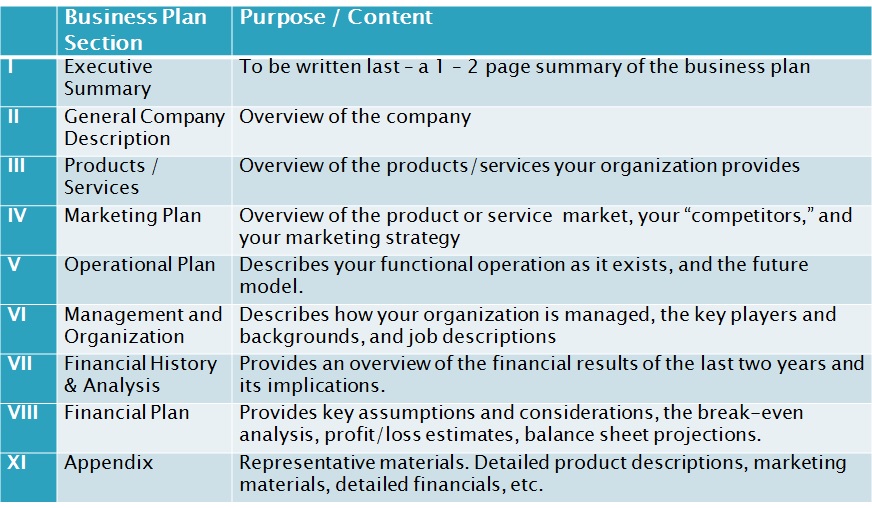Your Business Plan – The Basics
"Arguably, the most critical sections of your business plan are: products / services description, the marketing plan, and the financial plan."
The Small Business Administration (sba.gov) has tons of resources to help you get started with writing your business plan. If you're going after SBA funding, you'll need to ensure that your written plan conforms to their requirements.
Even if you aren't considering SBA funding, writing your business plan still makes sense. The process of constructing your plan forces you to go through a disciplined process of thinking through how your business will operate and compete, and with diligence and little luck, make money.
Your business plan works to:
- Clarify your thinking about the impact of your product or service mix, the likely revenue and expenses associated with production, your ability to penetrate your market, and your ability to expand operations and enter new markets.
- Demonstrate to potential investors (or donors if your business is a not-for-profit) that you've done your homework and understand the challenges.
- Get your management team on the same page, working from the same plan.
- Define operational benchmarks and organizational milestones for the next several years.
Your business plan can become a living document, in that when there are significant changes in the competitive environment, the plan needs to reflect how you expect to adapt.
Arguably, the most critical sections of your business plan are:
- Products / Services Description
- Marketing Plan
- Financial Plan
These sections of the plan should show the consistency that indicates the fundamental relationships between marketing activity (how many can you expect to sell), products/services that answer a demonstrated need in the market, and the financial plan (the cost of production and other costs are balanced against expected revenue).
If these sections of the plan fail the consistency test, it's likely that you've missed something in your thinking.
See the tabs below for a high-level example of consistency between these components in a hypothetical mobile dog-grooming service.
Part of the challenge when you're in start-up mode is that you don't often know: a) how much marketing activity it takes to sell a unit of the product/service of the type you want to sell, b) how much it costs to produce a unit of the product/service, and c) what you should charge for a unit of your product/service to cover your costs and make a profit.
One way to approach it is to research industry "benchmarks." These are typical ranges of costs or production levels that are similar to what you want to produce and sell. Gathering industry intelligence provides better information, which can lead to a better plan.
Sometimes, it means you may opt to take advantage of many free services that are available, such as the SBA, or a local Small Business Development Council, or SCORE. There is a ton of information available on the Internet. You can talk to your potential competitors directly to understand the challenges they have faced and had to overcome.
The more effective time you spend in the research phase, the better understanding you will have of the product and business prospects. Capturing those insights in the business plan can lay a stronger foundation for operations and growth.
Your company provides mobile dog-grooming services for all breed s of dogs. You have outfitted your truck with two bays, fur shampoo, brushes, water tanks, scissors, clippers and the other necessary instruments to ensure you can deliver a clean and well manicured dog.
s of dogs. You have outfitted your truck with two bays, fur shampoo, brushes, water tanks, scissors, clippers and the other necessary instruments to ensure you can deliver a clean and well manicured dog.
You provide a one-hour service, package and that time-frame become part of your marketing promise.
You schedule in advance for most of your clients, as you will be in specific neighborhoods on a regular schedule.
Your research has shown that there is a reliable source for an online calculator that can estimate the number of dogs in a a given neighborhood, based on national averages.
Using the calculator, you determine that there are about 40K+ households with pets, and those households support about 67K dogs.
You have identified neighborhoods that are further than 20 minutes driving time from any PetSmart (or similar store). And you've further narrowed it down to neighborhoods with an above average number of senior citizens. Based on those more narrow criteria, you estimate there are about 15,000 dogs that you might be able to provide services for.
You expect to saturate local grocery stores with bulletin board flyers, use windshield flyers, work with apartment managers, and cruise neighborhoods in your van. You also expect to pay a small referral fee to people who recommend your service, because you know that word-of-mouth is a powerful marketing tool.
You have also researched what competitive services are charging for a similar dog-grooming service package in order to determine the "going rate" for those services.
You have estimated that your average dog-grooming service package takes about 1 hour. With two bays in the truck and with help, in an 8 hour day you may be able to handle no more than 12 dogs.
Your weekly maximum throughput is 60 dogs. Given that figure, you may be able to handle no more than 1200 dogs in a year.
Based on the estimated population of 15K dogs, you have estimated that the "average dog" gets a bath every 6 weeks. That means there are 90,000 dog-baths being delivered by someone every 6 weeks, or more than 750K dog-baths in the areas you want to service, each year. Your capacity means that you only need to capture a very small percentage of those dog-baths, which is now a reasonable assumption.
You're going to incur marketing costs, supply costs, transportation costs. You also have some relatively fixed costs related to the acquisition of your truck (loan payments, insurance, maintenance, etc).
Using these factors, you are now equipped to build a financial model that illustrates your costs and revenue projections, helps you to build your cost-volume-profit model, and helps lay the groundwork for your proforma financial statements.



Recent Comments